Hebe (mythology)
Hebe (/ˈhiːbiː/; Greek: Ἥβη) in ancient Greek religion, is the goddess of youth or the prime of life[1] (Roman equivalent: Juventas).[2] She is the daughter of Zeus and his older sister, Hera.[3] Hebe was the cupbearer for the gods and goddesses of Mount Olympus, serving their nectar and ambrosia until she married Heracles (Roman equivalent: Hercules); her successor was the divine hero Ganymede. Another title of hers for this reason is Ganymeda, meaning "Gladdening Princess". Hebe was worshipped as the goddess of forgiveness or mercy at Sicyon.[4]
| Hebe | |
|---|---|
Goddess of eternal youth, prime of life, forgiveness Cupbearer to the gods | |
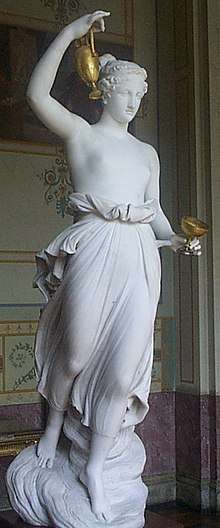 Hebe by Antonio Canova, 1800–05 (Hermitage, St. Petersburg) | |
| Abode | Mount Olympus |
| Symbol | Wine-cup, Eagle, Ivy, Fountain of Youth, and Wings |
| Personal information | |
| Parents | Zeus and Hera |
| Siblings | Aeacus, Angelos, Apollo, Ares, Artemis, Athena, Dionysus, Eileithyia, Enyo, Ersa, Helen of Troy, Heracles, Hermes, Minos, Pandia, Persephone, Perseus, Rhadamanthus, the Graces, the Horae, the Litae, the Muses, the Moirai |
| Consort | Heracles |
| Children | Alexiares and Anicetus |
| Roman equivalent | Juventas |
Hebe had influence over eternal youth[5] and the ability to restore youth to mortals, a power that appears exclusive to her, as in Ovid's Metamorphoses, some gods lament their favoured mortals aging. According to Philostratus the Elder, Hebe was youngest of the gods and responsible for keeping them eternally young, and thus was the most revered by them.[6] Her role of ensuring the eternal youth of the other gods is appropriate with her role of serving as cupbearer, as the word ambrosia has been linked to a possible Proto-Indo-European translation related to immortality, undying, and lifeforce.[7] In art, she is typically seen with her father in the guise of an eagle, often offering a cup to him. This depiction is seen in classical engraved gems as well as later art. Eagles were connected with immortality and there was a folklore belief that the eagle (like the phoenix) had the ability to renew itself to a youthful state, making the association with Hebe logical.[8]
Etymology
The Ancient Greek: ἥβη is the inherited word for "youth", from Proto-Indo-European *(H)iēgw-eh2-, "youth, vigour".[9]
The name Hebe comes from the Greek word meaning "youth" or "prime of life". Juventus likewise means "youth", as can be seen in such derivatives as juvenile.
Mythology
Hebe is the daughter of Zeus and his older sister, Hera, and was seen in myth as a diligent daughter performing domestic tasks that were typical of high ranking, unmarried girls in ancient Greece.[10] In the Iliad, she performed tasks around the household such as drawing baths for her brother Ares[11] and helping Hera enter her chariot.[12] Pindar in Nemean Ode 10 refers to her as the most beautiful of the goddesses, and being by her mother's side in Olympus forever. Although she was not as strongly associated with her father, Hebe was occasionally referred to with the epithet Dia (see Cult), which can be translated to "Daughter of Zeus" or "Heavenly". In some traditions that were recorded by Servius, her father Zeus gifted her two doves with human voices, and one flew to where the Oracle of Dodona would be established.[13] Additionally, Hebe was often connected to Aphrodite, whom she was described dancing with and acting as her herald or attendant, linking the Classical association between beauty and "the bloom of youth".[14][15] In Euripedes' play Orestes, Helen is said to sit on a throne beside Hera and Hebe upon obtaining immortality.
One of her roles was to be the cupbearer to the gods, serving them ambrosia and nectar.[16] In Classical sources, Hebe's departure from this role was due to her marriage to the deified hero Heracles. Despite this, in the Iliad Hebe serves all the gods at their heavenly feast were Ganymede is exclusively Zeus's wine-pourer.[17] Additionally, Cicero seems to imply that either Hebe or Ganymede, who is typically seen as her successor, could serve in the role of cupbearer at the heavenly feast.[18] The reasoning for Hebe's dismissal was transformed into a moralizing story in the 1500s by the Church of England, where it was stated in a note in an English-Latin dictionary that Hebe fell while in attendance to the gods, causing her dress to become undone, exposing her naked body publicly.[19] Although there is no Classical literary or artistic source for this account, the story was modified to function as a warning to women to stay modestly covered at all times, as naked women in particular were seen as shameful by the Church.[19] During this period, Hebe was strongly associated with spring, so this addition of Hebe falling to the myth was also allegorized to represent the change of season from spring to autumn.[20]
In a rare, alternative version of Hebe's conception, her mother Hera became pregnant merely by eating a lettuce plant while dining with her fellow Olympian, Apollo.[21][22] This version was recorded by famed Italian mythographer Natalis Comes.[21] Reconstructed Orphic beliefs may also present a different version of Hera's impregnation with Hebe.[23] It should be remembered that this version of the myth of Hebe's birth is a speculative reconstruction, and therefore, it likely does not represent how the myth would have been known to its original audience. In this version, Hera sought out a way to become pregnant without assistance of Zeus by travelling to realm of Oceanus and Tethys at the end of the world. There, she entered the garden of Flora and she touched a sole, nameless plant from the land of Olene and became pregnant with Ares.[23] Hera returned to the garden sometime after his birth and ate lettuce to become pregnant with Hebe.[23] The consumption of lettuce in Ancient Greece was connected to sexual impotency in men and women, with Plutarch recording that women should never eat the heart of a lettuce.[23] Additionally, lettuce was associated with death, as Aphrodite laid the dying Adonis in a patch to potential aid in his reconstruction.[21] Despite these concerns, it was also believed that lettuce benefited menstrual flow and lactation in women, characteristics that may associate the plant with motherhood.[23] This version of Hebe's paternity is referenced by American author Henry David Thoreau in his work Walden, where Hebe is described as the daughter of Juno and wild lettuce.
%2C_dalla_banditaccia%2C_530_ac._ca.%2C_ercole_all'olimpo_su_quadriga_con_ebe_1.jpg)
A fragment by Callimachus describes Hera holding a feast to celebrate the seventh day after her daughter Hebe's birth.[24] The gods have a friendly argument over who will give the best gift, with Athena, Poseidon, Apollo, and Hephaestus specifically mentioned as presenting toys or, as in Apollo's case, songs. Callimachus, who composed a poem for the celebration of the seventh day after the birth of a daughter to his friend Leon, used Apollo's gift of a song as a divine prototype for his own gift.[25]
As the bride of Heracles, Hebe was strongly associated with both brides and her husband in art and literature. Hebe was the patron of brides, due to being the daughter of Hera and the importance of her own wedding. In some depictions on vase paintings, such as the Ricci Hydria dated to approximately 525 B.C.E., Hebe drives a chariot and is the one to bring her future husband, Heracles, to Olympus from Earth upon his apotheosis, a role traditionally fulfilled by Athena.[26][27] A Krator in the Cleveland Museum may depict Hebe in chariot ready to leave Olympus to retrieve her husband in the presence of her mother, Artemis, and Apollo.[28] The lost comedic play, Hebes Gamos ("The Marriage of Hebe") by Epicharmus of Kos, depicted the wedding feast of Hebe and Heracles.[27] In Theocritus’s Encomium of Ptolemy Philadelphus, Herakles dines with Ptolemy I and Alexander at a feast on Olympus and after he has his fill of nectar, he bestows his bow and arrows and club to them and leaves for the Hebe's chamber.[29][30] Here the couple is presented as one of the paradigms for marriage of Philadelphus and Arsinoe with Herakles retiring to Hebe's chambers in a scene reminiscent of a wedding.[29] Catullus in Poem 68 makes a positive reference to the legal marriage of Heracles to the virginal goddess Hebe to contrast with the poet's secret affair with a married woman.[31] Propertius also makes a reference to Herakles feeling a blazing love for Hebe upon his death at Mount Oeta, altering the traditional myth where Herakles marries Hebe after ascending to divinity.[32] Hebe's role as the patron of brides is referenced in Edmund Spenser's Epithalamion, where the poem also connects her to the fertility of the bride.[20]
Hebe had two children with Heracles: Alexiares and Anicetus.[33] Although nothing is known about these deities beyond their names, there is a fragment by Callimachus that makes a reference to Eileithyia, Hebe's sister and the goddess of childbirth, attending to her while in labour.[34]
According to some Classical authors, Hebe was connected to maintaining the youth and immortality of the other gods. Philostratus the Elder states that she is the reason the other gods are eternally young, and Bacchylides alleges that Hebe, as the princess (basileia), is responsible for immortality.[6][35] This is another justification for her marriage to Heracles, as it ensures not only his immortality but also eternal youth, which were not viewed as equivalent in myths, such as with the case of Tithonus. In Euripides' play Heracleidae and in Ovid's Metamorphoses, Hebe grants Iolaus' wish to become young again in order to fight Eurystheus.
Cult
Hebe was particularly associated with the worship of her mother Hera in Argos and in the Heraion of Argos, one of the main centres of worship of Hera in Greece. It was said that Hebe, in a statue made of ivory and gold, was depicted standing beside a very large statue of Hera, which depicted the goddess seated holding a pomegranate and sceptre with a cuckoo perched on top.[36] A relief made of silver above an alter depicted the marriage of Hebe and Heracles.[36] Both of these depictions have been lost, but Argive coins have been found showing these two statues side by side.[37] It is possible the Hebe was worshipped as or represented the virginal aspect of Hera or that her worship was with her mother was similar to that of Demeter and Persephone, as both potentially represented the cycle of rebirth and renewal.[38][37] Some scholars theorize that one of the Temples of Hera at Paestum may have been dedicated to Hera and Hebe rather than to Hera and Zeus, which is the more common consensus.[26] Scholars point to the headless bust of a well-dressed young girl that may have served as the antefix or acroterion of the temple as possibly being a representation of Hebe.[26] Hebe was also depicted, alongside Athena, standing beside a sitting statue of Hera in the Temple of Hera at Mantinea in Arkadia, sculptured by Praxiteles.[39]
Hebe also appears to be worshipped jointly with other figures as well. There is a record of a priestess from the deme of Aexone who served both Hebe and Alkmene being rewarded with a crown of olive leaves for her service.[40] Aelian also refer to Hebe being worshipped in a temple that was adjacent to a temple dedicated to her spouse Herakles in an unknown location.[41] The temples, which were separated by a canal, housed roosters in Herakles's temple and hens in Hebe's temple. Chickens were not commonly associated with either deity and more typically associated with Apollo.[42] Some scholars have indicated that in Assyria, Apollo was particularly associated with Hebe.[43]
Hebe also had her own personal cult and at least one temple in Greece dedicated to her. There was an altar for her in Athens at the Cynosarges.[44] This site also contained gymnasium and alters for Herakles and joint alter to Alcmene and Iolaus[45] In Sicyon, there was a temple dedicated to here and it was the center of her own cult. The Phliasians, who lived near Sicyon, honored Hebe (whom they called Dia, meaning "Daughter of Zeus") by pardoning supplicants. Hebe was also worshipped as a goddess of pardons or forgiveness; freed prisoners would hang their chains in the sacred grove of her sanctuary at Phlius. Pausanias described the Temple of Hebe: "A second hill on which the Phliasians [of Phlios in Argolis] have their citadel and their sanctuary of Hebe."[4] He also described the cult of Hebe around the sanctuary:
- "On the Phliasian citadel [at Phlios in Argolis] is a grove of cypress trees and a sanctuary which from ancient times has been held to be peculiarly holy. The earliest Phliasians named the goddess to whom the sanctuary belongs Ganymeda; but later authorities call her Hebe, whom Homer mentions in the duel between Menelaos (Menelaus) and Alexandros (Alexander), saying that she was the cup-bearer of the gods; and again he says, in the descent of Odysseus to Haides, that she was the wife of Heracles. Olen [a legendary Greek poet], in his hymn to Hera, says that Hera was reared by the Horai (Horae, Seasons), and that her children were Ares and Hebe. Of the honours that the Phliasians pay to this goddess the greatest is the pardoning of suppliants. All those who seek sanctuary here receive full forgiveness, and prisoners, when set free, dedicate their fetters on the trees in the grove. The Phliasians also celebrate a yearly festival which they call Kissotomoi (Ivy-cutters). There is no image, either kept in secret of openly displayed, and the reason for this is set forth in a sacred legend of theirs though on the left as you go out is a temple of Hera with an image of Parian marble."[46]
Ancient art
In art, Hebe is usually depicted wearing a sleeveless dress, typically she was depicted with either one or both her parents, at her wedding ceremony, or with Aphrodite.
Hebe was occasionally depicted with wings, which has led to confusion by modern scholars on whether depictions of winged female attendants are Hebe, Iris, or Nike. One confirmed depiction of Hebe with wings, as determined by the Η above the figure's head, on a cup by Sosias.[26] Hebe is presumably between enthroned parents as she waits for her future husband Heracles, who directed towards her by Athena, Apollo, and Hermes. Another notable depiction of a winged Hebe is by the Castelgiorgio painter on a cup, who pairs her with her mother and Ganymede analogously with Zeus; Ares stands in the centre of the scene indicating familial harmony.[26]
It is possible that she is one of the winged figures from the Parthenon pediment in the British Museum, as the figure stands as an attendant to Hera and is near Zeus and Ares.[47] The figure could also represent Iris or Nike, but contextual evidence arguably makes the identification as Hebe more likely.[48] The depiction of Eros with his mother Aphrodite on the same frieze have been equated to Hebe's position to Hera, as the group seems to pay attention to the young maidens approaching from the right side of the eastern frieze. The two pairs were connected with love and weddings/marriage respectively, which would allude to the young maidens who would soon be married.[48] Another possible connection between the pairs is that Hebe and Eros are portrayed as children who are still dependent on their mothers and stay close to them as a result.[47] The identification of the figure as Hebe would also make sense due to the proximity to Zeus and Ares, her father and brother. Ares and Hebe here are represented as the product of a legal marriage, reinforcing the sacred marriage between Zeus and Hera, which gives an example of a prolific marriage to the mortal pair shown in the centre of the eastern frieze.[48]
Hebe may have been the Acroterion on the Temple of Ares in the Athenian Agora.[49] Hebe may have also been depicted on a fragmentary votive relief that was excavated near the Erechtheion, which shows Heracles being crowned by Nike, who places her left arm around another goddess's shoulders.[50] However, Hebe was not connected with Nike, leading most scholars to believe this goddess is Athena.[50]
As the goddess of the brides, Hebe was often portrayed in wedding scenes. A notable depiction of Hebe comes from an Archaic Attic Black Figure dions dated to 580 – 570 B.C.E., which is attributed to Sophilos and held in the British Museum, depicts Hebe as part of a procession of gods arriving at the house of Peleus to celebrate his wedding to Thetis.[51][26] Here Hebe is the most prominent goddess in the procession, appearing alone and without a cloak covering her shoulders like most the other goddess in attendance. She wears an elaborate dress with the patterns of animals and geometric shapes and wears earrings. Her hair is shown to be bound with three braids worn over her shoulder. Her prominent position may be due to her association with feasts, being the patron of brides, or because a mortal man is marrying a goddess, referencing her own marriage to Heracles.[51] Hebe is also a prominent figure on a 5th-century epinetron by the Eretria Painter depicting preparations for the wedding of Harmonia.[26] The bride sits in the centre of the scene on a stool and is surrounded by her friends who prepare her for her wedding as her mother, Aphrodite, oversees the process. The depiction reinforces Hebe's connection to weddings and brides.
In post-classical art
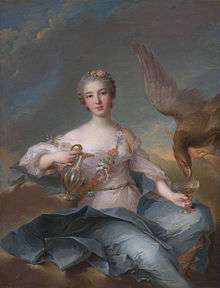
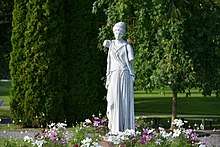
Hebe was a remarkably popular subject in art in the period from about 1750 to 1880, having attracted little artistic attention before or after. In the later period, many depictions were portraits of ladies as Hebe, for which at a minimum the only modifications to a normal costume needed were a flowing white dress, some flowers in the hair and a cup to hold. Most artists added an eagle and a setting amid the clouds. In French there was a special term, "en Hébé", for the costume. The personification appears in rococo, Grand Manner and Neoclassical styles. Even some very aristocratic models allowed a degree of nudity, such as exposing a single breast, though this was often much greater in non-portrait depictions.
Jean-Marc Nattier painted a Rohan princess as Hebe in 1737,[52] and then the royal Louise Henriette of Bourbon, Duchess of Orléans (1744) and another duchess the same year as Hebe, the latter with a breast exposed. François-Hubert Drouais painted Marie-Antoinette, when Dauphine, en Hébé in 1773, and Angelica Kauffman and Gaspare Landi both painted several Hebes. Notably, the Mercure de France addressed Marie-Antoinette as Hebe upon her marriage.[53] Louise Élisabeth Vigée Le Brun tells in her memoirs how she painted the 16-year-old Miss Anna Pitt, daughter of Thomas Pitt, Lord Camelford, as Hebe in Rome, with a real eagle she borrowed from Cardinal de Bernis. The bird was furious at being brought indoors to her studio and badly frightened her, though it looks relatively harmless in the painting (now in the Hermitage Museum).[54] An entirely nude depiction by Ignaz Unterberger was a huge success in Vienna in 1795, and bought by Emperor Francis II for a large amount; the artist was also made a court painter.[55]
In sculpture Hebe began to flourish as a subject slightly later, but continued longer. Hubert Gerhard created an early statue of Hebe in 1590 that is currently on display at the Detroit Institute of Arts, which depicts her naked, holding her dress in one hand and a cup raised above her head in another. She rests one foot upon a tortoise, a gesture associated with Aphrodite Urania. Antonio Canova sculpted four different versions of his statue of Hebe, and there are many later copies.[56] This had no accompanying eagle, but including the bird was a challenge accepted by several later sculptors. An elaborate marble group with a naked Hebe and the eagle with wings outspread was started in 1852 by the elderly François Rude but unfinished by his death in 1855. Finished by his widow and another it is now in the Musée des Beaux-Arts de Dijon and was very popular in bronze versions, with one in Chicago.[57] Albert-Ernest Carrier-Belleuse produced another spectacular group, with the eagle perched above a sleeping Hebe (1869, now Musée d'Orsay, Paris). Jean Coulon (1853–1923) produced another group about 1886, with versions in the Musée des Beaux-Arts de Nice, Nice and the Stanford Museum in California.
Especially in America, figures of Hebe continued to be popular in the late 19th century and early 20th century for garden fountains and temperance fountains, and statues were widely available in cast stone. Tarentum, Pennsylvania, United States displays two such cast stone statues of Hebe.[58] The mold for these statues was donated to the borough by the Tarentum Book Club on 6 June 1912. In Vicksburg, Mississippi, the Bloom Fountain installed in 1927 near the municipal rose garden, thanks to a bequest of $6,500 in the will of Louis Bloom, features a Hebe of cast zinc. At Bowling Green, Kentucky, the Hebe fountain in Fountain Square follows Canova's model, in patinated cast iron, purchased in 1881 from the J. L. Mott Iron Works of New York, at a cost of $1500.[59] Similar Hebe fountains, probably also from Mott, are located in Court Square, Memphis, Tennessee and in Montgomery, Alabama, and one with bronze patination was formerly the Starkweather Fountain in Ypsilanti, Michigan, installed in 1889.[60]
There is a bronze statue of Hebe, by Robert Thomas; (1966), in Birmingham city centre, England.[61]
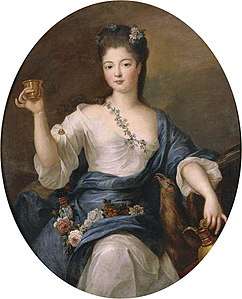
.jpg) Gavin Hamilton, 1767
Gavin Hamilton, 1767.jpg) François-Hubert Drouais, Marie-Antoinette, en Hébé, 1773
François-Hubert Drouais, Marie-Antoinette, en Hébé, 1773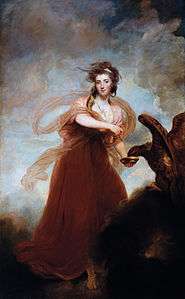 Joshua Reynolds, 1785, Mrs. Musters as Hebe
Joshua Reynolds, 1785, Mrs. Musters as Hebe.jpg) Gaspare Landi 1790, using a model
Gaspare Landi 1790, using a model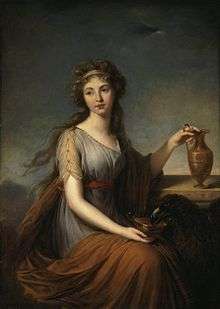 Elisabeth Vigée-Lebrun, Portrait of Anna Pitt as Hebe, 1792
Elisabeth Vigée-Lebrun, Portrait of Anna Pitt as Hebe, 1792- Princess Teofila Radziwiłł, wife of Dominik Hieronim Radziwiłł, by Józef Peszka, 1802–06
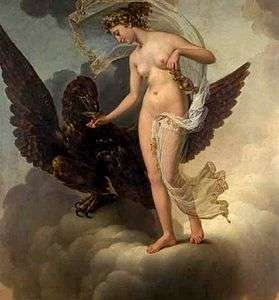 Charles Picqué, 1826
Charles Picqué, 1826- The Dijon marble group by François Rude
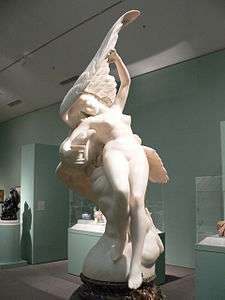 Jean Coulon, about 1886
Jean Coulon, about 1886- Carolus-Duran; usually a portraitist, but not here
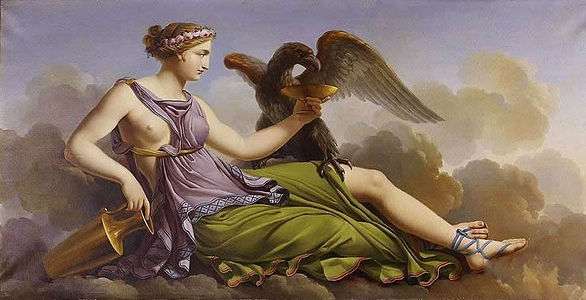 Hebe by Jacques Louis Dubois (French), 19th century
Hebe by Jacques Louis Dubois (French), 19th century
Genealogy
| Hebe's family tree | ||||||||||||||||||||||||||||||||||||||||||||||||||||||||||||||||||||||||||||||||||||||||||||||||||||||||||||||||||||||||||||||||||||||||||||||||||||||||||||||||||||||||||||||||||||||||||||||||||||||||||||||||||||||||||||||||||||||||||||||||||||||||||||||||||||||||||||||||||||||||||||||||||||||||||||||||||||||||||||||||||||||||||||||||||||||||||||||||||||||||||||||
|---|---|---|---|---|---|---|---|---|---|---|---|---|---|---|---|---|---|---|---|---|---|---|---|---|---|---|---|---|---|---|---|---|---|---|---|---|---|---|---|---|---|---|---|---|---|---|---|---|---|---|---|---|---|---|---|---|---|---|---|---|---|---|---|---|---|---|---|---|---|---|---|---|---|---|---|---|---|---|---|---|---|---|---|---|---|---|---|---|---|---|---|---|---|---|---|---|---|---|---|---|---|---|---|---|---|---|---|---|---|---|---|---|---|---|---|---|---|---|---|---|---|---|---|---|---|---|---|---|---|---|---|---|---|---|---|---|---|---|---|---|---|---|---|---|---|---|---|---|---|---|---|---|---|---|---|---|---|---|---|---|---|---|---|---|---|---|---|---|---|---|---|---|---|---|---|---|---|---|---|---|---|---|---|---|---|---|---|---|---|---|---|---|---|---|---|---|---|---|---|---|---|---|---|---|---|---|---|---|---|---|---|---|---|---|---|---|---|---|---|---|---|---|---|---|---|---|---|---|---|---|---|---|---|---|---|---|---|---|---|---|---|---|---|---|---|---|---|---|---|---|---|---|---|---|---|---|---|---|---|---|---|---|---|---|---|---|---|---|---|---|---|---|---|---|---|---|---|---|---|---|---|---|---|---|---|---|---|---|---|---|---|---|---|---|---|---|---|---|---|---|---|---|---|---|---|---|---|---|---|---|---|---|---|---|---|---|---|---|---|---|---|---|---|---|---|---|---|---|---|---|---|---|---|---|---|---|---|---|---|---|---|---|---|---|---|---|---|---|---|---|---|---|---|---|---|---|---|---|---|---|---|---|---|---|---|---|
| ||||||||||||||||||||||||||||||||||||||||||||||||||||||||||||||||||||||||||||||||||||||||||||||||||||||||||||||||||||||||||||||||||||||||||||||||||||||||||||||||||||||||||||||||||||||||||||||||||||||||||||||||||||||||||||||||||||||||||||||||||||||||||||||||||||||||||||||||||||||||||||||||||||||||||||||||||||||||||||||||||||||||||||||||||||||||||||||||||||||||||||||
See also
- Hebephilia
- Hebephrenia
- Hebe Tian (Taiwanese Actress)
Notes
- According to Kerényi, p. 98, "Hebe's name... means 'Flower of Youth'. She was another version of her mother in the latter's quality of Hera Pais, 'Hera the young maiden'."
- Ovid does not detect a unity of Hera (Juno) and Hebe (Juventus): he opens Fasti vi with a dispute between Juno and Juventus claiming patronage of the month of June (on-line text).
- Hesiod, Theogony 921–922; Homer, Odyssey 11. 604–605; Pindar, Isthmian 4.59–60; Apollodorus, 1.3.1, and later authors.
- Pausanias, Description of Greece 2. 12. 4 (trans. Jones)
- Chisholm, Hugh, ed. (1911). . Encyclopædia Britannica. 13 (11th ed.). Cambridge University Press. p. 166.
- Philostratus the Elder. Imagines (Book 2).
- Burkert, Walter (1985). Greek Religion. Cambridge, Massachusetts: Harvard University Press and Basil Blackwell Publisher. p. 22. ISBN 978-0-674-36281-9.
- Dale-Green, Patricia (1962). "The Golden Eagle". British Homoeopathic Journal. 51 (2): 128–133. doi:10.1016/S0007-0785(62)80052-0.
- R. S. P. Beekes, Etymological Dictionary of Greek, Brill, 2009, p. 507.
- Seemann, Otto (1887). The Mythology of Greece and Rome: With Special Reference to Its Use in Art. Harper & Brothers. p. 102. ISBN 978-1417976454.
- Homer, Iliad 5.905.
- Homer, Iliad 5.722.
- Cook, Arthur Bernard (1906). "Who Was the Wife of Zeus?". The Classical Review. 20 (7): 365–378. JSTOR 695286.
- Homeric Hymn 3 to Pythian Apollo. pp. 186 ff.
- Houston Smith, Robert (1992). "'Bloom of Youth': A Labelled Syro-Palestinian Unguent Jar". The Journal of Hellenic Studies. 122: 163–167. JSTOR 632163.
- Homer, Iliad 4.1
- Homer, Iliad 20.230
- Cicero. De Natura Deorum. pp. 1. 40.
- Loomis, Catherine (2013). Barrett-Graves, Debra (ed.). The Emblematic Queen: Extra-Literary Representations of Early Modern Queenship. New York: Palgrave Macmillan. p. 61. ISBN 9781137303097.
- Brumble, H. David (1998). Classical Myths and Legends in the Middle Ages and Renaissance: A Dictionary of Allegorical Meanings. London: Greenwood. pp. 149–150. ISBN 978-0313294518.
- Danielli, Mary (1952). "Andriantsihianika and the Clan of the Zanakantitra". Folklore. 63 (1): 46–47. JSTOR 1256765.
- Shri Bhagavatananda Guru, A Brief History of the Immortals of Non-Hindu Civilizations
- Detienne, Marcel (2003). "A Kitchen Garden for Women, or How to Engender on One's Own". The Writing of Orpheus: Greek Myth in Cultural Context. Translated by Lloyd, Janet. Baltimore, Maryland: Johns Hopkins University Press. pp. 50–58. ISBN 978-0-8018-6954-9.
- Callimachus. Iambi, Fragment 202.
- Bonner, Campbell (1951). "A new fragment of Callimachus". Aegyptus. 31 (2): 133–137. JSTOR 41215365.
- Jenifer, Neils (2004). Marconi, Clement (ed.). Greek Vases: Images, Contexts and Controversies. Boston, MA: BRILL. pp. 76–83. ISBN 978-90-04-13802-5.
- Holt, Philip (1992). "Herakles' Apotheosis in Lost Greek Literature and Art". L'Antiquité Classique. 61: 38–59. doi:10.3406/antiq.1992.1130.
- Neils, Jennifer (1996). "The Cleveland Painter". Cleveland Studies in the History of Art. 1: 12–29. JSTOR 20079680.
- Hunter, Richard (2003). Theocritus. Encomium of Ptolemy Philadelphus. Los Angeles, CA: University of California Press. pp. 77–125. ISBN 0520235606.
- Müller, Sabine (2015). "Poseidippos of Pella and the Memory of Alexander's Campaigns at the Ptolemaic Court". The Many Faces of War in the Ancient World. Newcastle upon Tyne, UK: Cambridge Scholars Publishing. pp. 140–141. ISBN 978-1443877688.
- Vandiver, Elizabeth (2000). "Hot Springs, Cool Rivers, and Hidden Fires: Heracles in Catullus 68.51–66". Classical Philology. 95 (2): 151–159. doi:10.1086/449482. JSTOR 270454.
- Rae, A. Lyn (1983). Propertius' use of myth in 1.20 (Masters). University of British Columbia.
- Apollodorus, 2.77.
- Callimachus. Fragment 524.
- Bacchylides. Vol. Greek Lyric IV. pp. Fragment 41.
- Pausanias. Description of Greece.
- O'Brien, Joan V. (1993). The Transformation of Hera: A Study of Ritual, Hero, and the Goddess in the Iliad. Lanham, Maryland: Rowman & Littlefield Publishers. pp. 135–141.
- Graves, Robert (1955). The Greek Myths. Penguin Books.
- Pausanias, Description of Greece 8. 9. 2
- Dillon, Matthew (2016). "48 'Chrysis the Hiereia having placed a lighted torch near the garlands then fell asleep' (Thucydides Iv.133.2): priestesses serving the gods and goddesses in Classical Greece". Women in Antiquity. New York, NY: Routledge. p. 1378. ISBN 978-1-315-62142-5.
- Aelian, On Animals 17. 46 (trans. Scholfield)
- Hekster, Olivier (2002). "Of Mice and Emperors: A Note on Aelian "De natura animalium" 6.40". Classical Philology. 97 (4): 365–370. doi:10.1086/449598. hdl:2066/104483. JSTOR 1215450.
- Martin, Catherine Gimelli (2014). "A review of "Vincenzo Cartari's Images of the Gods of the Ancients: The First Italian Mythography" edited and translated by John Mulryan". Seventeenth-Century News. 72: 267.
- Pausanias, Description of Greece 1. 19. 3
- Fredricksmeyer, E.A. (1979). "Divine Honors for Philip II". Transactions of the American Philological Association. 109: 49–50. JSTOR 284048.
- Pausanias, Description of Greece 2. 13. 3
- Neils, Jenifer (1999). "Reconfiguring the Gods on the Parthenon Frieze". The Art Bulletin. 81 (1): 6–21. doi:10.2307/3051284. JSTOR 3051284.
- Fehr, Burkhard (2011). Becoming Good Democrats and Wives: Civil Education and Female Socialization on the Parthenon Frieze. London: LIT Verlag Münster. pp. 113–116. ISBN 978-3-643-99900-9.
- Neils Boulter, Patricia (1953). "An Akroterion from the Temple of Ares in the Athenian Agora". Hesperia: The Journal of the American School of Classical Studies at Athens. 22 (3): 141–147. doi:10.2307/146761. JSTOR 146761.
- Palagia, Olga (2009). Art in Athens During the Peloponnesian War. New York, NY: Cambridge University Press. p. 37. ISBN 978-0-521-84933-3.
- Atsma, Aaron J. "K18.4 HEBE". Retrieved 2 December 2018.
- Charlotte Louise de Rohan (1722–1786), princesse de Masseran, daughter of Hercule Mériadec, Prince of Guéméné, now Palace of Versailles
- Barker, Nancy N. (1993). ""Let Them Eat Cake": The Mythical Marie Antoinette and the French Revolution". The Historian. 55 (4): 709–724. doi:10.1111/j.1540-6563.1993.tb00920.x. JSTOR 24448793.
- Her Memoirs, start of chapter III (in French); Portrait of Anna Pitt as Hebe
- A. Griffiths and F. Carey, German Printmaking in the Age of Goethe, London, 1994, pp. 90–92
- The original is in the Hermitage Museum, St Petersberg, with others in the Alte Nationalgalerie, Berlin and Museum of Forlì, Italy;
- Hebe and the Eagle of Jupiter, Art Institute of Chicago
- They are located at 40.59977°N 79.752621°W and 40.601603°N 79.757264°W).
- "The City of Bowling Green, Ky: Fountain Square". Archived from the original on 16 April 2010. Retrieved 9 January 2010.
- Ypsilanti Historical Society: "Lost Ypsilanti: The Starkweather Fountain"; the single figure of Hebe cost $750. Other cast zinc Hebe fountains by Mott and other manufacturers are documented by Carol A. Grissom, Zinc sculpture in America, 1850–1950 2009:301ff.
- Located at 52.484438°N 1.892175°W).
- Alcmene was the granddaughter of Perseus, and hence the great-granddaughter of Zeus.
- According to Homer, Iliad 1.570–579, 14.338, Odyssey 8.312, Hephaestus was apparently the son of Hera and Zeus, see Gantz, p. 74.
- According to Hesiod, Theogony 927–929, Hephaestus was produced by Hera alone, with no father, see Gantz, p. 74.
References
- Apollodorus, Apollodorus, The Library, with an English Translation by Sir James George Frazer, F.B.A., F.R.S. in 2 Volumes. Cambridge, Massachusetts, Harvard University Press; London, William Heinemann Ltd. 1921. Online version at the Perseus Digital Library.
- Kerényi, Carl, The Gods of the Greeks, Thames and Hudson, London, 1951.
- Gantz, Timothy, Early Greek Myth: A Guide to Literary and Artistic Sources, Johns Hopkins University Press, 1996, Two volumes: ISBN 978-0-8018-5360-9 (Vol. 1), ISBN 978-0-8018-5362-3 (Vol. 2).
- Hesiod, Theogony, in The Homeric Hymns and Homerica with an English Translation by Hugh G. Evelyn-White, Cambridge, Massachusetts., Harvard University Press; London, William Heinemann Ltd. 1914. Online version at the Perseus Digital Library.
- Homer, The Iliad with an English Translation by A.T. Murray, PhD in two volumes. Cambridge, Massachusetts., Harvard University Press; London, William Heinemann, Ltd. 1924. Online version at the Perseus Digital Library.
- Homer; The Odyssey with an English Translation by A.T. Murray, PH.D. in two volumes. Cambridge, Massachusetts., Harvard University Press; London, William Heinemann, Ltd. 1919. Online version at the Perseus Digital Library.
- Hymn to Hermes (4), in The Homeric Hymns and Homerica with an English Translation by Hugh G. Evelyn-White, Cambridge, Massachusetts., Harvard University Press; London, William Heinemann Ltd. 1914. Online version at the Perseus Digital Library.
- Pindar, Odes, Diane Arnson Svarlien. 1990. Online version at the Perseus Digital Library.
External links

| Preceded by Deianira |
Wives of Heracles | Succeeded by --- |